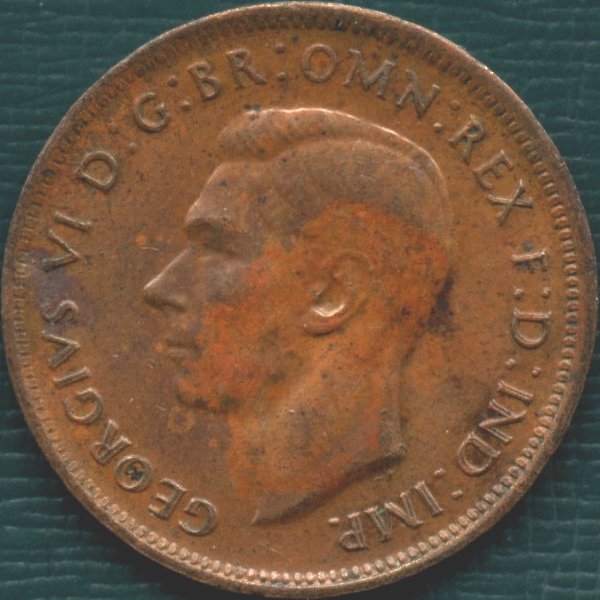

|
|
 |
Reverse. Nothing unusual here. |
 |
Note the doubling of the obverse legend. It is only the legend which is affected;
there is no doubling visible on the rim beads or on the effigy. The separation between
the letters is greatest near the bottom edge of the coin. |
Extracts of some correspondence with Paul Holland:
To: Paul Holland
From: Jon Saxton
Date: 24th December 1999
Now I'd like to ask you more about that 1943 halfpenny with the doubled obverse legend.
I understand that during the hobbing process a die might be struck more than once by the punch (and vice versa) and that if the registration were not perfect between strikes then such doubling might occur. In the case of the coin in question, it looks as though the die (or punch) rotated slightly about an axis in roughly the 1 o'clock position.
The thing which I can't understand is that it is only the legend which shows the doubling effect. There is no hint of doubling on the other design elements.
I can see how the doubling might occur during the preparation of the master die where each of the elements is punched separately but I can't imagine a master die with such doubling being used to create any working dies. I would have expected that all design elements would be in place on the master die and that any misalignment between strikes in the preparation of subsequent tools would be exhibited on the effigy and the rim denticles as well as on the legend.
Obviously something is lacking in my understanding of the process. (So much to learn.)
To: Jon Saxton
From: Paul Holland
Date: 27th December 1999
Jon,
I've had a chance to re-visit your website and more carefully examine the doubling of the obverse legend on your 1943 halfpenny. The suggestion that this die was struck from two different hubs can be eliminated since only one hub type (my obverse 2) was used from 1938-48 for Australian halfpennies. By way of background, in the production of dies, the larger penny sized coin typically required three blows of the punch (or hub) with annealing (or softening) of the die between blows, whereas the smaller halfpenny typically required two blows. As a result, whereas a few pennies exhibit "tripled dies", halfpennies are likely to exhibit only "doubled dies". In the specific example of the 1943 halfpenny on your webpage, the fact that the widest separation between the letters is seen near the bottom edge of the coin with almost no separation seen at the top indicates that this is "pivot doubling" where the second blow from the punch (or hub) was properly aligned with the first at the top, but not at the bottom. Since the second blow (showing the clearer image) occurred clockwise relative to the first, this might be described as a "nice example of pivot doubling with a clockwise rotation". That the doubling is only clearly visible on the legend, which has both high relief and "sharp" edges, is not untypical as low relief features from the first impression often tend to be obliterated and obscured during the die making process.
Hope this helps.
Best Regards,
Paul
To: Paul Holland
From: Jon Saxton
Date: 31st December 1999
Paul:
Thank you for your long reply to my query about the '43 halfpenny with the doubled lettering on the obverse. Everything you said made sense until I got to the last sentence:
> That the doubling is only clearly visible on the legend, which
> has both high relief and "sharp" edges, is not untypical as low
> relief features from the first impression often tend to be
> obliterated and obscured during the die making process.
I could accept that the effigy of George VI with its tapered edges might be obliterated by the second strike to the point where it would leave no sign of doubling, but I would have thought that the rim denticles were sufficiently well-defined to leave traces of the first impression. I wasn't totally comfortable with the explanation.
Then a thought occurred to me. I acquired that coin about eight months ago and I had only ever inspected it with a hand-held magnifier because that was all I had at the time. Sure enough, when I examined the coin under a decent microscope I found that traces of the first-strike denticles are indeed visible.
Now the discrepancy between observation and explanation has been resolved (by improving the observation) and I am happy. Thank you.
Do I have permission to quote your reply?
Happy New Year.